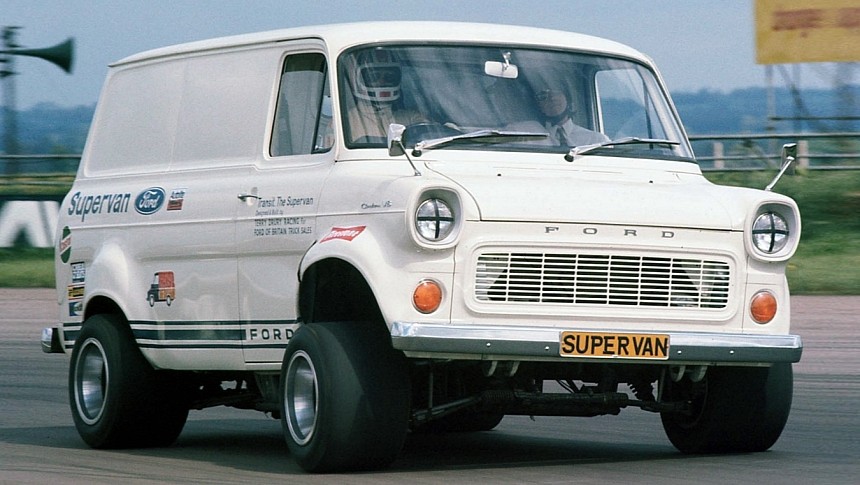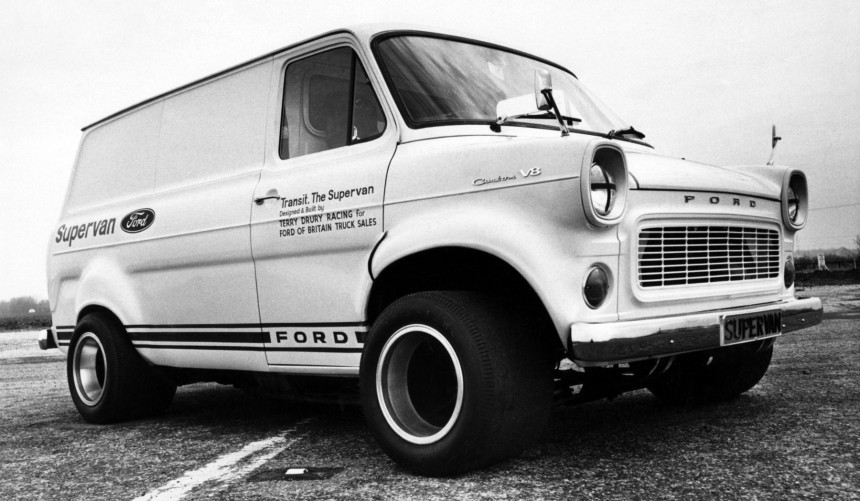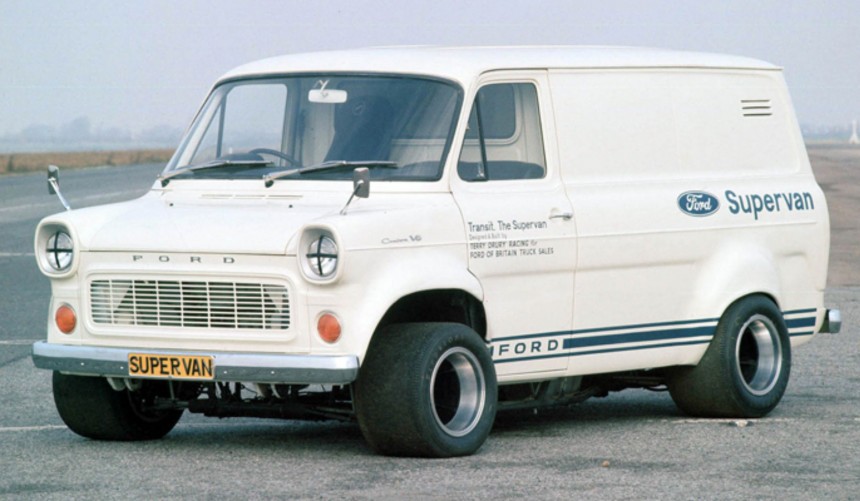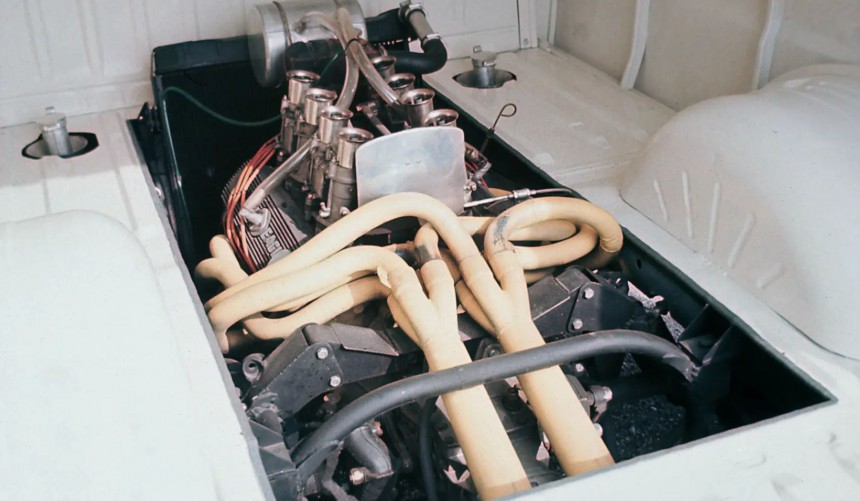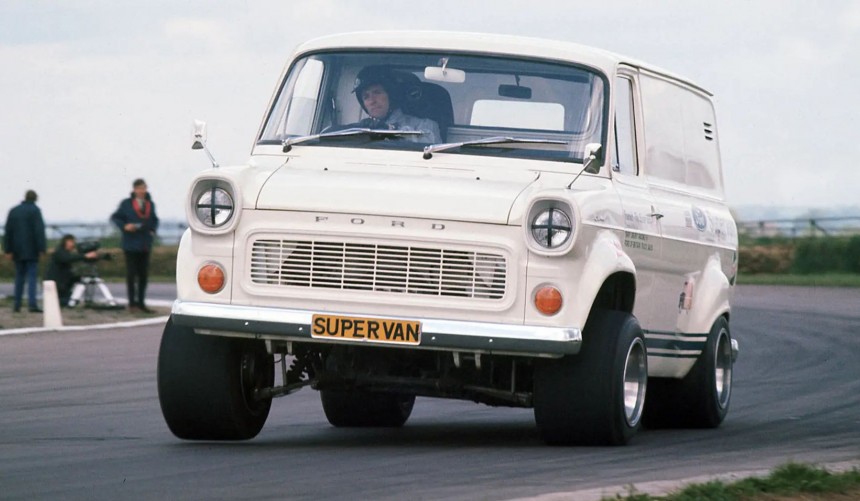During the early-1970s, Ford showcased the company’s most insane promotional vehicle: a Mark 1 Transit van that featured a modified chassis and a mid-mounted V8 borrowed from the Le Mans-winning GT40.
For decades, the biggest names in the automotive industry have created fascinating vehicles to promote their mass-produced models, future designs, or cutting-edge technologies. Ford has played this card better than most, building some iconic one-offs that worked wonders in terms of marketing but also made it into the automotive history books for being absolutely amazing.
More than half a century ago, the corporation’s engineers put together a mid-engine roadster that was successfully paraded around the U.S. to get the public hyped up about the first-generation Mustang. In recent times, they blew our minds with the 1,973-hp (2,000 ps) Pro Electric SuperVan that was created to promote the first mass-produced, fully-electric Transit.
Few remember that the latter was actually the fourth iteration of insane series of promotional vehicles that Ford had built throughout the years to boost the popularity of their trusty Transit. It all started in 1971 with an example of the very first generation, which was transformed into the GT40 of commercial vehicles.
Legend has it that the idea sprung up in the late-1960s when a team of young Ford apprentices stuffed a V8 engine into a Transit and drove it to several auto shows in the UK where it never failed to attract a crowd.
John Dale, an employee of Ford UK’s marketing department was present at one of these shows and realized that such a vehicle would be a great promotional tool for the mass-produced Transit. But rather than just swapping the engine of a stock van, Dale took the idea one step further and began thinking about the possibility of creating a “supervan” by putting a Transit body on a GT40 chassis.
He consulted with former race driver, Ford engineer, and well-known GT40 privateer Terry Drury who assured him that building such a four-wheeled insanity was doable. Next, Dale convinced the corporation’s decision-makers to fund the project and finally commissioned Drury to make it happen.
Unlike future iterations, which all used fully custom bodies made from fiberglass or carbon fiber, the original Supervan featured the Mark 1 Transit’s production body. Dale and the Ford marketing team wanted the vehicle to look like an everyday van but perform like a thoroughbred race car.
To do that, Drury went to great lengths to keep the structure as stock as possible. He took a GT40 tubular steel chassis and extensively modified it to accommodate the van’s body. The engineer kept the iconic race car’s rack-and-pinion steering system, while the suspension was a mix between the front setup of a Jaguar XJ6 and a rear assembly from a Cooper F1. Stopping power was provided by ventilated disc brakes also borrowed from the GT40.
The only noticeable modification made to the exterior was the addition of flared wheel arches meant to provide enough room for the wider 15-inch race wheels custom-made by Revolution for the outrageous van.
There was also another modification made to the body shell, but it wasn’t visible from the outside. Since the van was built around a GT40 chassis, the engine was placed in the middle, so a huge portion of the floor inside the cargo area had to be cut out.
The powerplant used for the Supervan came from one of the GT40s that Terry Drury’s team competed with during the late-1960s. The eight-cylinder displaced 4.0 liters, featured Gurney-Weslake cylinder heads, and four Webber carbs that helped send power to the rear wheels through the GT40’s original ZF five-speed transaxle. It also came with the original ‘bundle of snakes” exhaust manifolds connected to four-inch (10.1 cm) pipes that exited through the middle of the rear end.
The race-bred V8 made around 400 hp (406 ps), which was about five times more than what a typical mass-produced, V4-powered Mark 1 Transit could make. In terms of performance, this translated to a seven-second 0 to 60 mph (97 kph) sprint and a theoretical top speed of close to 190 mph (305 kph). I say “theoretical” because the engine and the transaxle’s gear ratios were not modified, but the aerodynamics (or lack thereof) of the van body made it way too dangerous for anyone to attempt reaching that speed.
Even though it was an extensive project which required a lot of work, the Supervan took only several months to complete. It made its public debut in the spring of 1971 at Brands Hatch where those in attendance could hear its engine scream long before they saw it passing by. It was loud and outrageous, so everyone stood up and cheered.
From that point on, it toured Europe’s most popular auto shows, made the front cover of countless automotive magazines, and was frequently showcased on the continent’s legendary tracks. On one occasion, it lapped the Nürburgring Nordschleife in nine minutes and 13 seconds during a race weekend showcase, which made it faster than many of the cars that competed in the race.
Despite its superstar status and cult following, the original Supervan was eventually scrapped by Ford due to increasing demand for genuine GT 40 components. Thankfully, original footage from the seventies has survived and you can watch it in the YouTube video below by FordHeritage.
But, since it proved to be one of the company’s most popular promotional vehicles, it was followed up by the Cosworth DFL-powered, Mark 2-based Supervan 2 in 1984, the 1994 Mark 3 facelift Transit Supervan 3 which used a Cosworth HB Formula 1 V8 (later replaced by a Pro Sports 3000 V6), and finally the monstrous Pro Electric SuperVan introduced last year at the Goodwood Festival of Speed.
More than half a century ago, the corporation’s engineers put together a mid-engine roadster that was successfully paraded around the U.S. to get the public hyped up about the first-generation Mustang. In recent times, they blew our minds with the 1,973-hp (2,000 ps) Pro Electric SuperVan that was created to promote the first mass-produced, fully-electric Transit.
Few remember that the latter was actually the fourth iteration of insane series of promotional vehicles that Ford had built throughout the years to boost the popularity of their trusty Transit. It all started in 1971 with an example of the very first generation, which was transformed into the GT40 of commercial vehicles.
The origins of the Supervan
John Dale, an employee of Ford UK’s marketing department was present at one of these shows and realized that such a vehicle would be a great promotional tool for the mass-produced Transit. But rather than just swapping the engine of a stock van, Dale took the idea one step further and began thinking about the possibility of creating a “supervan” by putting a Transit body on a GT40 chassis.
He consulted with former race driver, Ford engineer, and well-known GT40 privateer Terry Drury who assured him that building such a four-wheeled insanity was doable. Next, Dale convinced the corporation’s decision-makers to fund the project and finally commissioned Drury to make it happen.
Stock body and GT40 chassis
To do that, Drury went to great lengths to keep the structure as stock as possible. He took a GT40 tubular steel chassis and extensively modified it to accommodate the van’s body. The engineer kept the iconic race car’s rack-and-pinion steering system, while the suspension was a mix between the front setup of a Jaguar XJ6 and a rear assembly from a Cooper F1. Stopping power was provided by ventilated disc brakes also borrowed from the GT40.
The only noticeable modification made to the exterior was the addition of flared wheel arches meant to provide enough room for the wider 15-inch race wheels custom-made by Revolution for the outrageous van.
Mid-mounted V8 madness
The powerplant used for the Supervan came from one of the GT40s that Terry Drury’s team competed with during the late-1960s. The eight-cylinder displaced 4.0 liters, featured Gurney-Weslake cylinder heads, and four Webber carbs that helped send power to the rear wheels through the GT40’s original ZF five-speed transaxle. It also came with the original ‘bundle of snakes” exhaust manifolds connected to four-inch (10.1 cm) pipes that exited through the middle of the rear end.
The race-bred V8 made around 400 hp (406 ps), which was about five times more than what a typical mass-produced, V4-powered Mark 1 Transit could make. In terms of performance, this translated to a seven-second 0 to 60 mph (97 kph) sprint and a theoretical top speed of close to 190 mph (305 kph). I say “theoretical” because the engine and the transaxle’s gear ratios were not modified, but the aerodynamics (or lack thereof) of the van body made it way too dangerous for anyone to attempt reaching that speed.
Becoming an automotive superstar
From that point on, it toured Europe’s most popular auto shows, made the front cover of countless automotive magazines, and was frequently showcased on the continent’s legendary tracks. On one occasion, it lapped the Nürburgring Nordschleife in nine minutes and 13 seconds during a race weekend showcase, which made it faster than many of the cars that competed in the race.
Despite its superstar status and cult following, the original Supervan was eventually scrapped by Ford due to increasing demand for genuine GT 40 components. Thankfully, original footage from the seventies has survived and you can watch it in the YouTube video below by FordHeritage.
But, since it proved to be one of the company’s most popular promotional vehicles, it was followed up by the Cosworth DFL-powered, Mark 2-based Supervan 2 in 1984, the 1994 Mark 3 facelift Transit Supervan 3 which used a Cosworth HB Formula 1 V8 (later replaced by a Pro Sports 3000 V6), and finally the monstrous Pro Electric SuperVan introduced last year at the Goodwood Festival of Speed.
